Constructing the Ecological Security Pattern of Nujiang Prefecture Based on the Framework of “Importance–Sensitivity–Connectivity”
Abstract
:1. Introduction
2. Study Area and Data Sources
2.1. Study Area
2.2. Data Sources
3. Methods
3.1. Comprehensive Evaluation of Ecological Security
3.1.1. Importance Assessment of Ecosystem Services
3.1.2. Assessment of Ecological and Environmental Sensitivity
Soil Erosion Sensitivity
Susceptibility to Geological Disasters
3.1.3. Landscape Connectivity
3.2. Constructing Ecological Security Pattern
3.2.1. Identification of Ecological Sources and Points
3.2.2. Construction of Ecological Resistance Surface
- (1)
- The calculation formula of the modified ecological resistance coefficient based on noctilucent remote sensing data is as follows:where Ri is the resistance coefficient modified based on noctilucent data; NLi is the light index of grid i; NLa is the average light index of land use type a corresponding to i [64].
- (2)
- The calculation formula of the modified ecological resistance coefficient based on elevation data is as follows:where Rj is the ecological resistance coefficient modified based on elevation value; DEMi is the elevation value of grid i; DEMa is the average elevation value of land-use type a corresponding to i [65].
3.2.3. Identification of Ecological Corridors
3.2.4. Identification of Ecological Nodes
4. Results
4.1. Importance Assessment of Ecosystem Services
4.2. Ecological and Environmental Sensitivity Assessment
4.3. Landscape Connectivity Evaluation
4.4. Comprehensive Evaluation of Ecological Security
4.5. Constructing the Ecological Security Pattern
4.5.1. Identification of Ecological Sources and Ecological Points
4.5.2. Identification of Ecological Corridors and Ecological Nodes
5. Discussion
5.1. Discussion on Comprehensive Ecological Security and Ecological Corridors
5.2. Measures and Suggestions for Optimizing Ecological Security Pattern
5.3. Deficiencies and Prospects
6. Conclusions
- (1)
- The importance of ecosystem services was higher in the west and lower in the east. The ecological environment of Nujiang is characterized by a small number of more and most sensitive areas which are distributed in discontinuous bands along both sides of Nujiang river and Lantsang River, and the high-sensitive areas of the ecological environment were distributed discontinuously along the banks of the Nujiang and the Lantsang River. The areas with high landscape connectivity were distributed in patches in the Gaoligong Mountain Nature Reserve and the Biluo Snow Mountain, and the areas with high landscape connectivity were primarily distributed in the high-altitude ice-covered land of Gongshan County and densely populated areas along the banks of Nujiang River and Lantsang River.
- (2)
- The overall ecological security was in a good state. The level of ecological security in the whole Nujiang Prefecture varied greatly, with the western region significantly higher than the eastern. Low ecological security areas were primarily distributed in Lanping County and the southeast region of Lushui City, and high ecological security areas were primarily distributed in nature reserve areas.
- (3)
- By constructing the ecological security pattern in Nujiang Prefecture, the total areas of primary and secondary ecological sources were 3281.35 km2 and 4224.64 km2, accounting for 22.32% and 28.73% of the total area of the prefecture, respectively. The spatial distribution of the primary and secondary ecological sources was found to be uneven and primarily distributed in nature reserves and natural scenic spots. The study identified 11 primary ecological points, 17 secondary ecological points, and 26 ecological corridors with a total length of 755.40 km, and 39 secondary ecological corridors with a total length of 929.26 km. The study additionally identified three river corridors with a total length of 550.472 km, and 82 ecological nodes comprising 26 strategic points, 36 breaking points, and 20 pose points.
Author Contributions
Funding
Institutional Review Board Statement
Informed Consent Statement
Data Availability Statement
Acknowledgments
Conflicts of Interest
References
- Mekonnen, M.M.; Hoekstra, A.Y. Four billion people facing severe water scarcity. Sci. Adv. 2016, 2, e1500323. [Google Scholar] [CrossRef] [PubMed]
- Kummu, M.; Guillaume, J.H.A.; de Moel, H.; Eisner, S.; Floerke, M.; Porkka, M.; Siebert, S.; Veldkamp, T.I.E.; Ward, P.J. The world’s road to water scarcity: Shortage and stress in the 20th century and pathways towards sustainability. Sci. Rep. 2016, 6, 38495. [Google Scholar] [CrossRef]
- Roe, D. Biodiversity loss-more than an environmental emergency Comment. Lancet Planet. Health 2019, 3, E287–E289. [Google Scholar] [CrossRef]
- Dirzo, R.; Raven, P.H. Global state of biodiversity and loss. Annu. Rev. Environ. Resour. 2003, 28, 137–167. [Google Scholar] [CrossRef]
- Meliho, M.; Khattabi, A.; Mhammdi, N. Spatial assessment of soil erosion risk by integrating remote sensing and GIS techniques: A case of Tensift watershed in Morocco. Environ. Earth Sci. 2020, 79, 207. [Google Scholar] [CrossRef]
- Guerra, C.A.; Rosa, I.M.D.; Valentini, E.; Wolf, F.; Filipponi, F.; Karger, D.N.; Xuan, A.N.; Mathieu, J.; Lavelle, P.; Eisenhauer, N. Global vulnerability of soil ecosystems to erosion. Landsc. Ecol. 2020, 35, 823–842. [Google Scholar] [CrossRef]
- Rapport, D.J. Ecosystemsnotoptimized: A reply. J. Aquat. Ecosyst. Health 1993, 2, 57. [Google Scholar] [CrossRef]
- Su, Y.; Chen, X.; Liao, J.; Zhang, H.; Wang, C.; Ye, Y.; Wang, Y. Modeling the optimal ecological security pattern for guiding the urban constructed land expansions. Urban For. Urban Green. 2016, 19, 35–46. [Google Scholar] [CrossRef]
- Li, S.; Zhao, Y.; Xiao, W.; Yue, W.; Wu, T. Optimizing ecological security pattern in the coal resource-based city: A case study in Shuozhou City, China. Ecol. Indic. 2021, 130, 108026. [Google Scholar] [CrossRef]
- Kang, J.; Zhang, X.; Zhu, X.; Zhang, B. Ecological security pattern: A new idea for balancing regional development and ecological protection. A case study of the Jiaodong Peninsula, China. Glob. Ecol. Conserv. 2021, 26, e01472. [Google Scholar] [CrossRef]
- Mao, X.; Meng, J.; Xiang, Y. Cellular automata-based model for developing land use ecological security patterns in semi-arid areas: A case study of Ordos, Inner Mongolia, China. Environ. Earth Sci. 2013, 70, 269–279. [Google Scholar] [CrossRef]
- Franklin, J.E.; Forman, R.T.T. Creating landscape patterns by forest cutting: Ecological consequences and principles. Landsc. Ecol. 1987, 1, 5–18. [Google Scholar] [CrossRef]
- Yu, H.; Gu, X.; Liu, G.; Fan, X.; Zhao, Q.; Zhang, Q. Construction of Regional Ecological Security Patterns Based on Multi-Criteria Decision Making and Circuit Theory. Remote Sens. 2022, 14, 527. [Google Scholar] [CrossRef]
- Xiao, S.; Wu, W.; Guo, J.; Ou, M.; Pueppke, S.G.; Ou, W.; Tao, Y. An evaluation framework for designing ecological security patterns and prioritizing ecological corridors: Application in Jiangsu Province, China. Landsc. Ecol. 2020, 35, 2517–2534. [Google Scholar] [CrossRef]
- Gao, S.; Sun, H.; Cao, G.; Zhao, L.; Wang, R.; Xu, M. Dynamic assessment of island ecological security under urbanization: A case study of Pingtan Island in the Southeast Coast of China. Environ. Earth Sci. 2018, 77, 531. [Google Scholar] [CrossRef]
- Wang, Z.; Shi, P.; Zhang, X.; Tong, H.; Zhang, W.; Liu, Y. Research on Landscape Pattern Construction and Ecological Restoration of Jiuquan City Based on Ecological Security Evaluation. Sustainability 2021, 13, 5732. [Google Scholar] [CrossRef]
- Wang, B.; Yu, F.; Teng, Y.; Cao, G.; Zhao, D.; Zhao, M. A SEEC Model Based on the DPSIR Framework Approach for Watershed Ecological Security Risk Assessment: A Case Study in Northwest China. Water 2022, 14, 106. [Google Scholar] [CrossRef]
- Wang, D.; Huang, Z.; Wang, Y.; Mao, J. Ecological security of mineral resource-based cities in China: Multidimensional measurements, spatiotemporal evolution, and comparisons of classifications. Ecol. Indic. 2021, 132, 160–168. [Google Scholar] [CrossRef]
- Fu, Y.; Shi, X.; He, J.; Yuan, Y.; Qu, L. Identification and optimization strategy of county ecological security pattern: A case study in the Loess Plateau, China. Ecol. Indic. 2020, 112, 106030. [Google Scholar] [CrossRef]
- Peng, J.; Pan, Y.; Liu, Y.; Zhao, H.; Wang, Y. Linking ecological degradation risk to identify ecological security patterns in a rapidly urbanizing landscape. Habitat Int. 2018, 71, 110–124. [Google Scholar] [CrossRef]
- Santini, L.; Saura, S.; Rondinini, C. Connectivity of the global network of protected areas. Divers. Distrib. 2016, 22, 199–211. [Google Scholar] [CrossRef]
- Saura, S.; Bastin, L.; Battistella, L.; Mandrici, A.; Dubois, G.J.E.I. Protected areas in the world’s ecoregions: How well connected are they? Ecol. Indic. 2017, 76, 144–158. [Google Scholar] [CrossRef]
- Kong, Y. Landscape ecological security patterns in biological conservation. Acta Ecol. Sin. 1999, 19, 8–15. [Google Scholar]
- Peng, J.; Yang, Y.; Liu, Y.; Hu, Y.n.; Du, Y.; Meersmans, J.; Qiu, S. Linking ecosystem services and circuit theory to identify ecological security patterns. Sci. Total Environ. 2018, 644, 781–790. [Google Scholar] [CrossRef]
- Peng, J.; Zhao, H.; Liu, Y.J.A.E.S. Urban ecological corridors construction: A review. Acta Ecol. Sin. 2017, 37, 23–30. [Google Scholar] [CrossRef]
- Wang, C.X.; Yu, C.Y.; Chen, T.Q.; Feng, Z.; Hu, Y.C.; Wu, K.N. Can the establishment of ecological security patterns improve ecological protection? An example of Nanchang, China. Sci. Total Environ. 2020, 740, 140051. [Google Scholar] [CrossRef] [PubMed]
- Beita, C.M.; Murillo, L.F.S.; Alvarado, L.D.A. Ecological corridors in Costa Rica: An evaluation applying landscape structure, fragmentation-connectivity process, and climate adaptation. Conserv. Sci. Pract. 2021, 3, e475. [Google Scholar] [CrossRef]
- dos Santos, A.R.; Araujo, E.F.; Barros, Q.S.; Fernandes, M.M.; Fernandes, M.R.D.; Moreira, T.R.; de Souza, K.B.; da Silva, E.F.; Silva, J.P.M.; Santos, J.S.; et al. Fuzzy concept applied in determining potential forest fragments for deployment of a network of ecological corridors in the Brazilian Atlantic Forest. Ecol. Indic. 2020, 115, 106423. [Google Scholar] [CrossRef]
- Beaujean, S.; Nor, A.N.M.; Brewer, T.; Zamorano, J.G.; Dumitriu, A.C.; Harris, J.; Corstanje, R. A multistep approach to improving connectivity and co-use of spatial ecological networks in cities. Landsc. Ecol. 2021, 36, 2077–2093. [Google Scholar] [CrossRef]
- Jongman, R.H.G.; Kulvik, M.; Kristiansen, I. European ecological networks and greenways. Landsc. Urban Plan. 2004, 68, 305–319. [Google Scholar] [CrossRef]
- Montoya, J.M.; Pimm, S.L.; Sole, R.V. Ecological networks and their fragility. Nature 2006, 442, 259–264. [Google Scholar] [CrossRef] [PubMed]
- Sole, R.V.; Montoya, J.M. Complexity and fragility in ecological networks. Proc. R. Soc. B-Biol. Sci. 2001, 268, 2039–2045. [Google Scholar] [CrossRef] [PubMed]
- Wang, Y.; Zhou, C. Landscape Ecological Security Pattern in Central Guizhou Urban Agglomeration. J. Ecol. Rural Environ. 2019, 35, 1111–1117. [Google Scholar]
- Han, Y.; Yu, C.; Feng, Z.; Du, H.; Huang, C.; Wu, K. Construction and Optimization of Ecological Security Pattern Based on Spatial Syntax Classification-Taking Ningbo, China, as an Example. Land 2021, 10, 380. [Google Scholar] [CrossRef]
- Aminzadeh, B.; Khansefid, M. Improving the Natural and Built Ecological Systems in an Urban Environment. Int. J. Environ. Res. 2010, 4, 361–372. [Google Scholar]
- Li, J.; Song, C.; Cao, L.; Zhu, F.; Meng, X.; Wu, J. Impacts of landscape structure on surface urban heat islands: A case study of Shanghai, China. Remote Sens. Environ. 2011, 115, 3249–3263. [Google Scholar] [CrossRef]
- Vergnes, A.; Kerbiriou, C.; Clergeau, P. Ecological corridors also operate in an urban matrix: A test case with garden shrews. Urban Ecosyst. 2013, 16, 511–525. [Google Scholar] [CrossRef]
- Liang, J.; He, X.; Zeng, G.; Zhong, M.; Gao, X.; Li, X.; Li, X.; Wu, H.; Feng, C.; Xing, W.; et al. Integrating priority areas and ecological corridors into national network for conservation planning in China. Sci. Total Environ. 2018, 626, 22–29. [Google Scholar] [CrossRef]
- Peng, J.; Li, H.; Liu, Y.; Hu, Y.n.; Yang, Y. Identification and optimization of ecological security pattern in Xiong’an New Area. Acta Geogr. Sin. 2018, 73, 701–710. [Google Scholar]
- Huang, C.; Yi, X.; Huang, G.; Yuan, S.; Wang, J.; Lai, Y. Construction of ecological security pattern of Tong’an District, Xiamen City. Trop. Geogr. 2018, 38, 10. [Google Scholar]
- Zhang, L.; Peng, J.; Liu, Y.; Wu, J. Coupling ecosystem services supply and human ecological demand to identify landscape ecological security pattern: A case study in Beijing-Tianjin-Hebei region, China. Urban Ecosyst. 2017, 20, 701–714. [Google Scholar] [CrossRef]
- Guo, R.; Wu, T.; Liu, M.; Huang, M.; Stendardo, L.; Zhang, Y. The Construction and Optimization of Ecological Security Pattern in the Harbin-Changchun Urban Agglomeration, China. Int. J. Environ. Res. Public Health 2019, 16, 1190. [Google Scholar] [CrossRef] [PubMed]
- Chen, J.; Wang, S.; Zou, Y. Construction of an ecological security pattern based on ecosystem sensitivity and the importance of ecological services: A case study of the Guanzhong Plain urban agglomeration, China. Ecol. Indic. 2022, 136, 108688. [Google Scholar] [CrossRef]
- Zhao, X.; Yue, Q.; Pei, J.; Pu, J.; Huang, P.; Wang, Q. Ecological Security Pattern Construction in Karst Area Based on Ant Algorithm. Int. J. Environ. Res. Public Health 2021, 18, 6863. [Google Scholar] [CrossRef]
- Xu, J.; Fan, F.; Liu, Y.; Dong, J.; Chen, J. Construction of Ecological Security Patterns in Nature Reserves Based on Ecosystem Services and Circuit Theory: A Case Study in Wenchuan, China. Int. J. Environ. Res. Public Health 2019, 16, 3220. [Google Scholar] [CrossRef] [PubMed] [Green Version]
- Kwon, O.S.; Kim, J.H.; Ra, J.H. Landscape Ecological Analysis of Green Network in Urban Area Using Circuit Theory and Least-Cost Path. Land 2021, 10, 847. [Google Scholar] [CrossRef]
- Huang, M.; Yue, W.; Feng, S.; Cai, J. Analysis of spatial heterogeneity of ecological security based on MCR model and ecological pattern optimization in the Yuexi county of the Dabie Mountain Area. J. Nat. Resour. 2019, 34, 771–784. [Google Scholar] [CrossRef]
- LiDing, C.; BoJie, F.U.; WenWu, Z. Source-sink landscape theory and its ecological significance. Acta Ecol. Sin. 2006, 26, 1444–1449. [Google Scholar]
- Yang, Y.; Wang, Y.; Cheng, X.; Li, W.; Gao, M.; Wang, J.; Fu, L.; Zhang, R. Establishment of an ecological security pattern based on connectivity index: A case study of the Three Gorges Reservoir Area in Chongqing. Acta Ecol. Sin. 2020, 40, 5124–5136. [Google Scholar]
- Xiao, Y.; Xie, G.; An, K. The function and economic value of soil conservation of ecosystems in Qinghai-Tibet Plateau. Acta Ecol. Sin. 2003, 23, 2367–2378. [Google Scholar]
- Zhao, T.; Ou, Y.; Jia, L.; Zheng, H. Ecosystem services and their valuation of China grassland. Acta Ecol. Sin. 2004, 24, 1101–1110. [Google Scholar]
- Huang, M.; Yue, W.; Feng, S.; Zhang, J. Spatial-temporal evolution of habitat quality and analysis of landscape patterns in Dabie Mountain area of west Anhui province based on InVEST model. Acta Ecol. Sin. 2020, 40, 2895–2906. [Google Scholar]
- Tsou, J.Y.; Gao, Y.; Zhang, Y.; Sun, G.; Ren, J.; Li, Y. Evaluating Urban Land Carrying Capacity Based on the Ecological Sensitivity Analysis: A Case Study in Hangzhou, China. Remote Sens. 2017, 9, 529. [Google Scholar] [CrossRef]
- Banos-Gonzalez, I.; Martinez-Fernandez, J.; Esteve-Selma, M.-A.; Esteve-Guirao, P. Sensitivity Analysis in Socio-Ecological Models as a Tool in Environmental Policy for Sustainability. Sustainability 2018, 10, 2928. [Google Scholar] [CrossRef]
- Zhang, M.; Jin, H.; Cai, D.; Jiang, C.J.P.E.S. The comparative study on the ecological sensitivity analysis in Huixian karst wetland, China. Procedia Environ. Sci. 2010, 2, 386–398. [Google Scholar]
- Shi, Y.; Li, J.; Xie, M. Evaluation of the ecological sensitivity and security of tidal flats in Shanghai. Ecol. Indic. 2018, 85, 729–741. [Google Scholar] [CrossRef]
- Zheng, Y.; Lan, S.; Chen, W.Y.; Chen, X.; Xu, X.; Chen, Y.; Dong, J. Visual sensitivity versus ecological sensitivity: An application of GIS in urban forest park planning. Urban For. Urban Green. 2019, 41, 139–149. [Google Scholar] [CrossRef]
- Renard, K.G.; Foster, G.R.; Weesies, G.A.; Mccool, D.K.; Yoder, D.C.J.A.H. Predicting Soil Erosion by Water: A Guide to Conservation Planning with the Revised Universal Soil Loss Equation (RUSLE); United States Department of Agriculture: Washington, DC, USA, 1997. [Google Scholar]
- Zhang, W.; Fu, J. Rainfall erosivity estimation under different rainfall amount. Resour. Sci. 2003, 25, 35–41. [Google Scholar]
- Williams, J.; Nearing, M.; Nicks, A.; Skidmore, E.; Valentin, C.; King, K.; Savabi, R. Using soil erosion models for global change studies. J. Soil Water Conserv. 1996, 51, 381–385. [Google Scholar]
- Saura, S.; Pascual-Hortal, L. A new habitat availability index to integrate connectivity in landscape conservation planning: Comparison with existing indices and application to a case study. Landsc. Urban Plan. 2007, 83, 91–103. [Google Scholar] [CrossRef]
- Saura, S.; Torne, J. Conefor Sensinode 2.2: A software package for quantifying the importance of habitat patches for landscape connectivity. Environ. Model. Softw. 2009, 24, 135–139. [Google Scholar] [CrossRef]
- Hu, Y.N.; Peng, J.; Liu, Y.X.; Tian, L. Integrating ecosystem services trade-offs with paddy land-to-dry land decisions: A scenario approach in Erhai Lake Basin, southwest China. Sci. Total Environ. 2018, 625, 849–860. [Google Scholar] [CrossRef] [PubMed]
- Wu, M.; Hu, M.; Wang, T.; Fan, C.; Xia, B. Recognition of urban ecological source area based on ecological security pattern and multi-scale landscape connectivity. Acta Ecol. Sin. 2019, 39, 4720–4731. [Google Scholar]
- Wu, P.; Lin, H.; Tian, L. Construction of ecological security pattern based on: A case study in Xiongan New Area, Hebei Province, China. J. Saf. Sci. Technol. 2018, 14, 5–11. [Google Scholar]
- Knaapen, J.P.; Scheffer, M.; Harms, B. Estimating habitat isolation in landscape planning. Landsc. Urban Plan. 1992, 23, 1–16. [Google Scholar] [CrossRef]
- Huang, X.; Cao, X.; Zhang, M.; Zou, X. Construction of Landscape Ecological Security Pattern of Shengli Coalfield in Inner Mongolia Based on the Minimum Cumulative Resistance Model. J. Ecol. Rural Environ. 2019, 35, 55–62. [Google Scholar]
- Zhang, X.; Jin, X.; Zhao, Q.; Ren, J.; Han, B.; Liang, X.; Zhou, Y. Identification and optimization of hierarchical ecological nodes based on multi-target genetic algorithm: Take Jintan district of Changzhou as an example. J. Nat. Resour. 2020, 35, 174–189. [Google Scholar]
- Luty, L.; Musial, K.; Ziolo, M. The Role of Selected Ecosystem Services in Different Farming Systems in Poland Regarding the Differentiation of Agricultural Land Structure. Sustainability 2021, 13, 6673. [Google Scholar] [CrossRef]
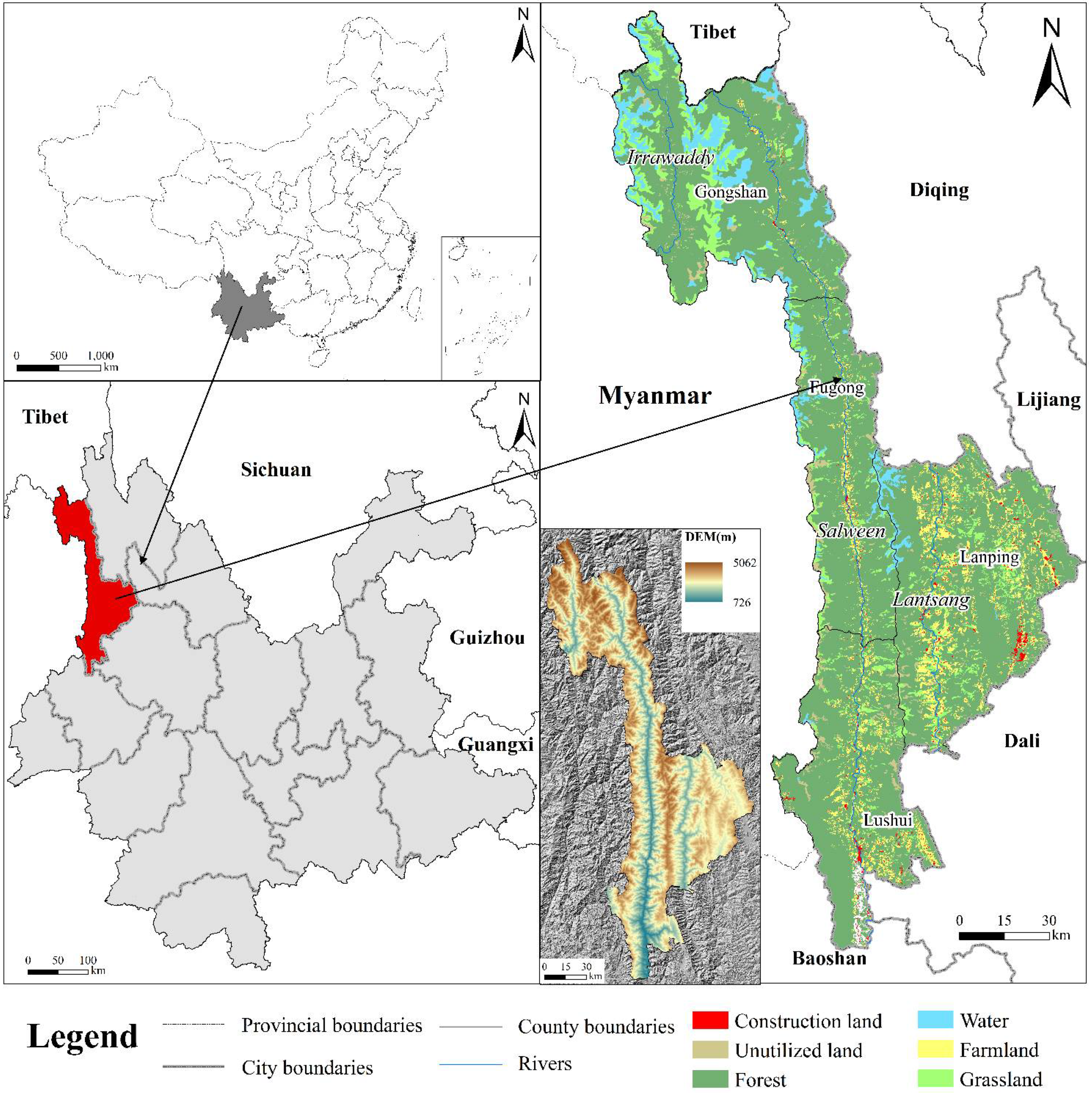


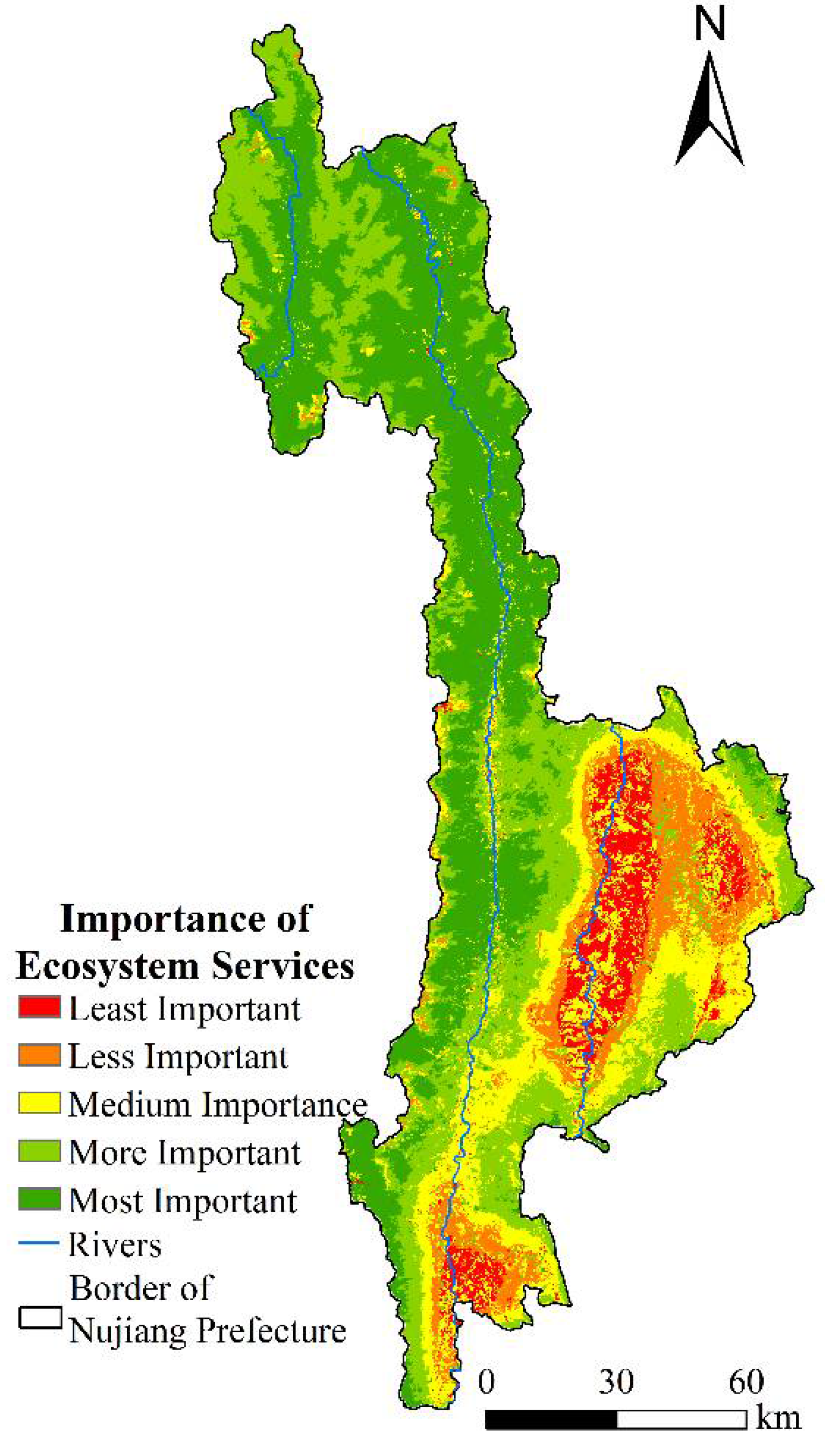
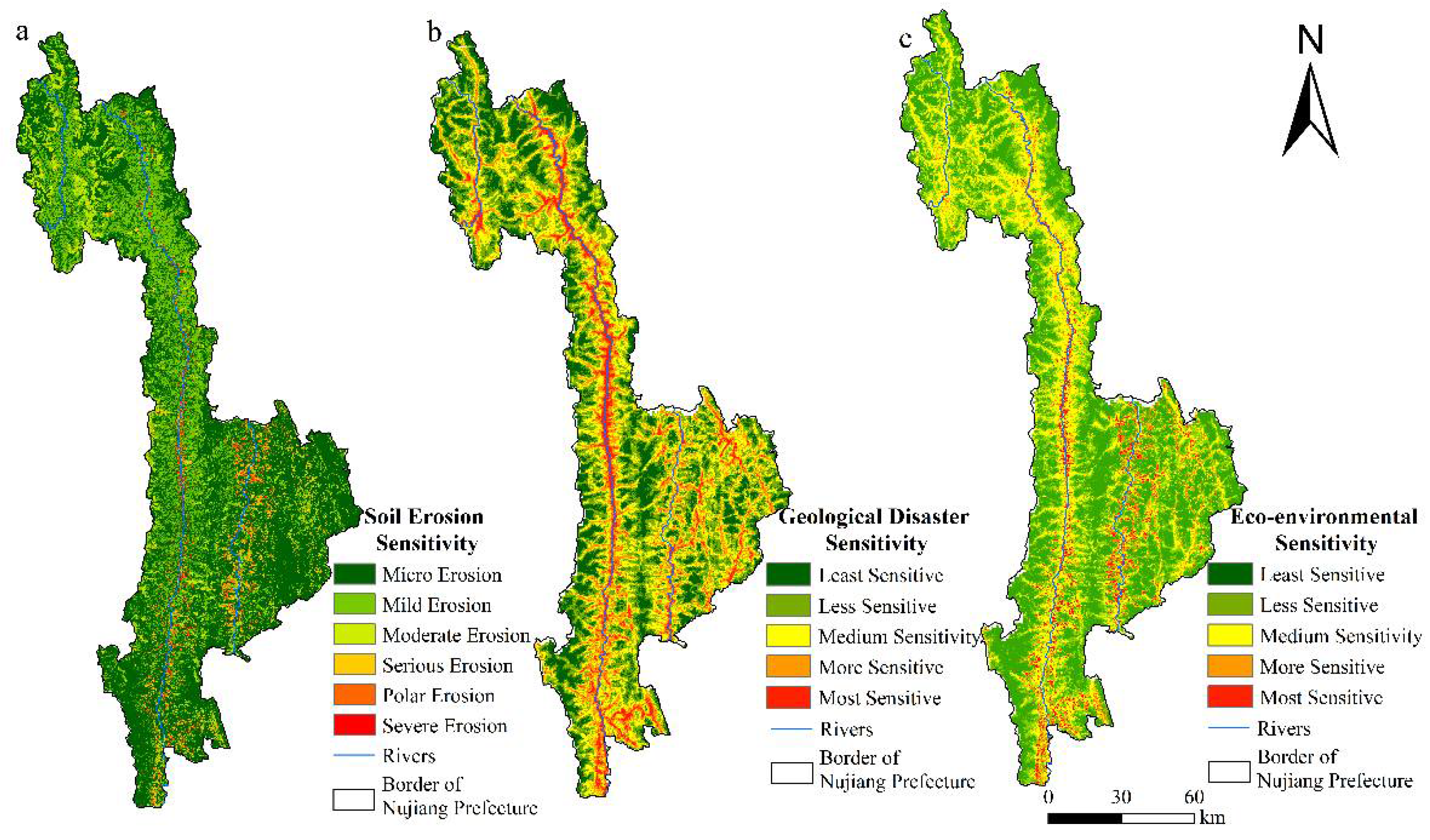
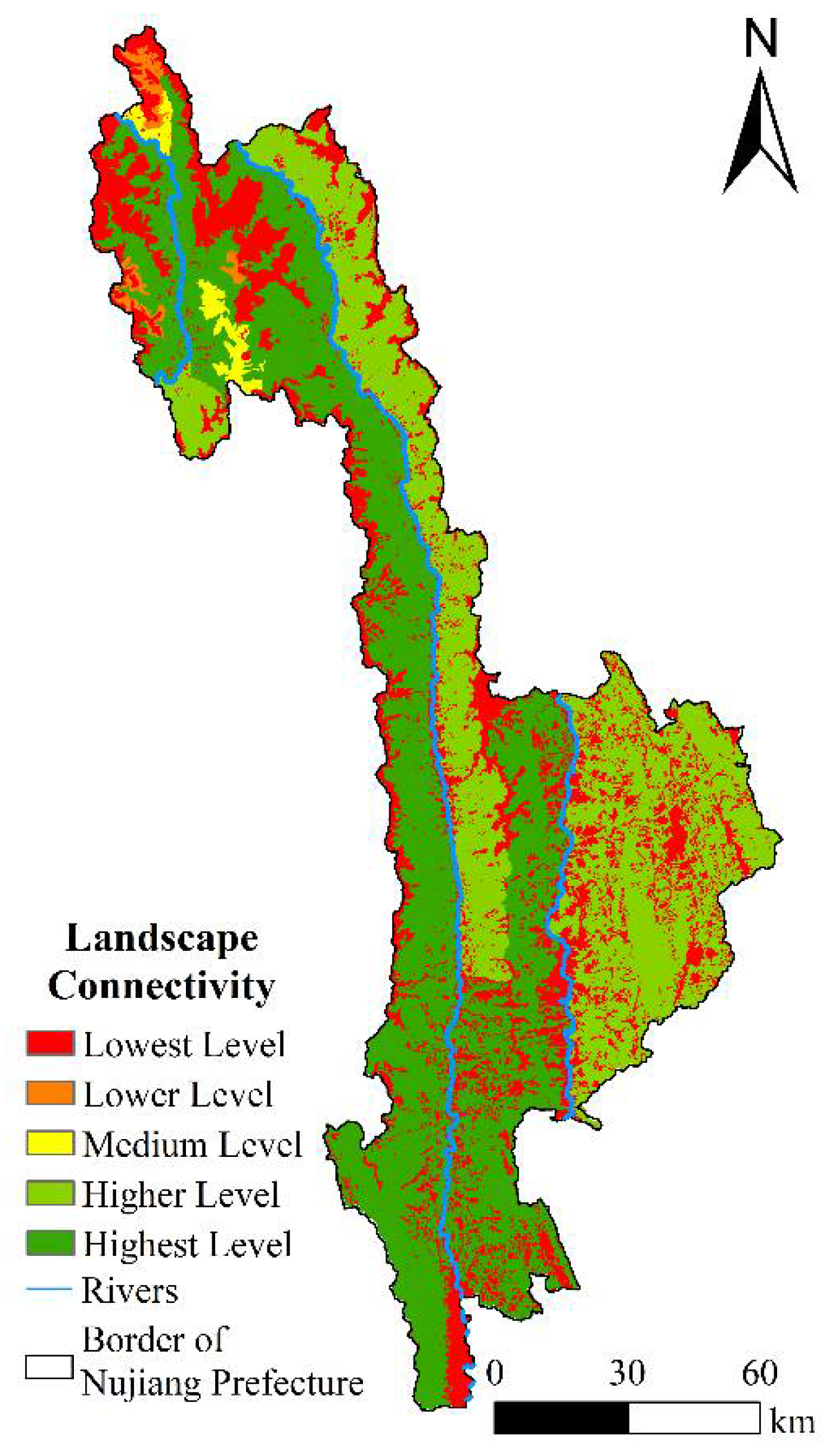
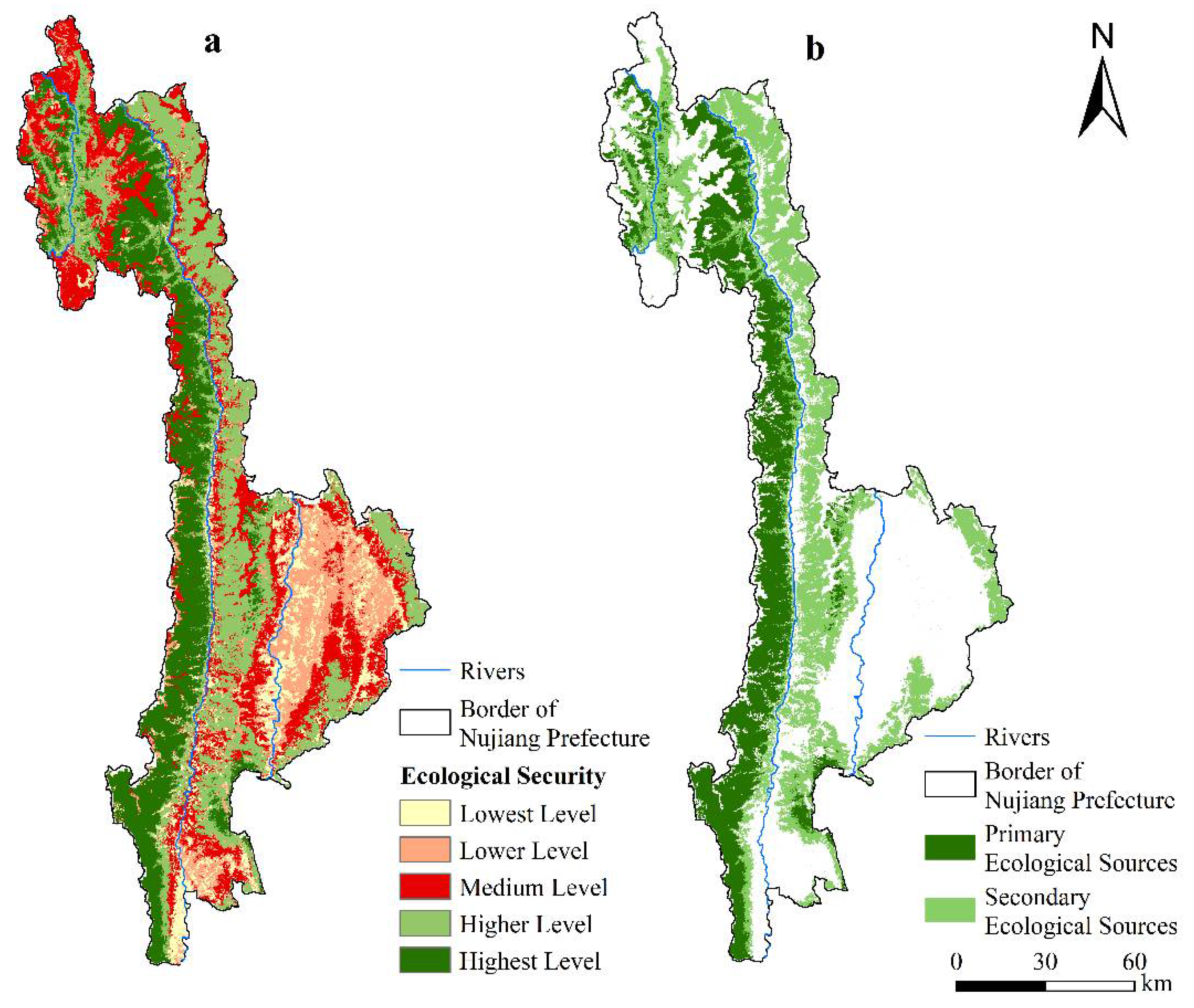
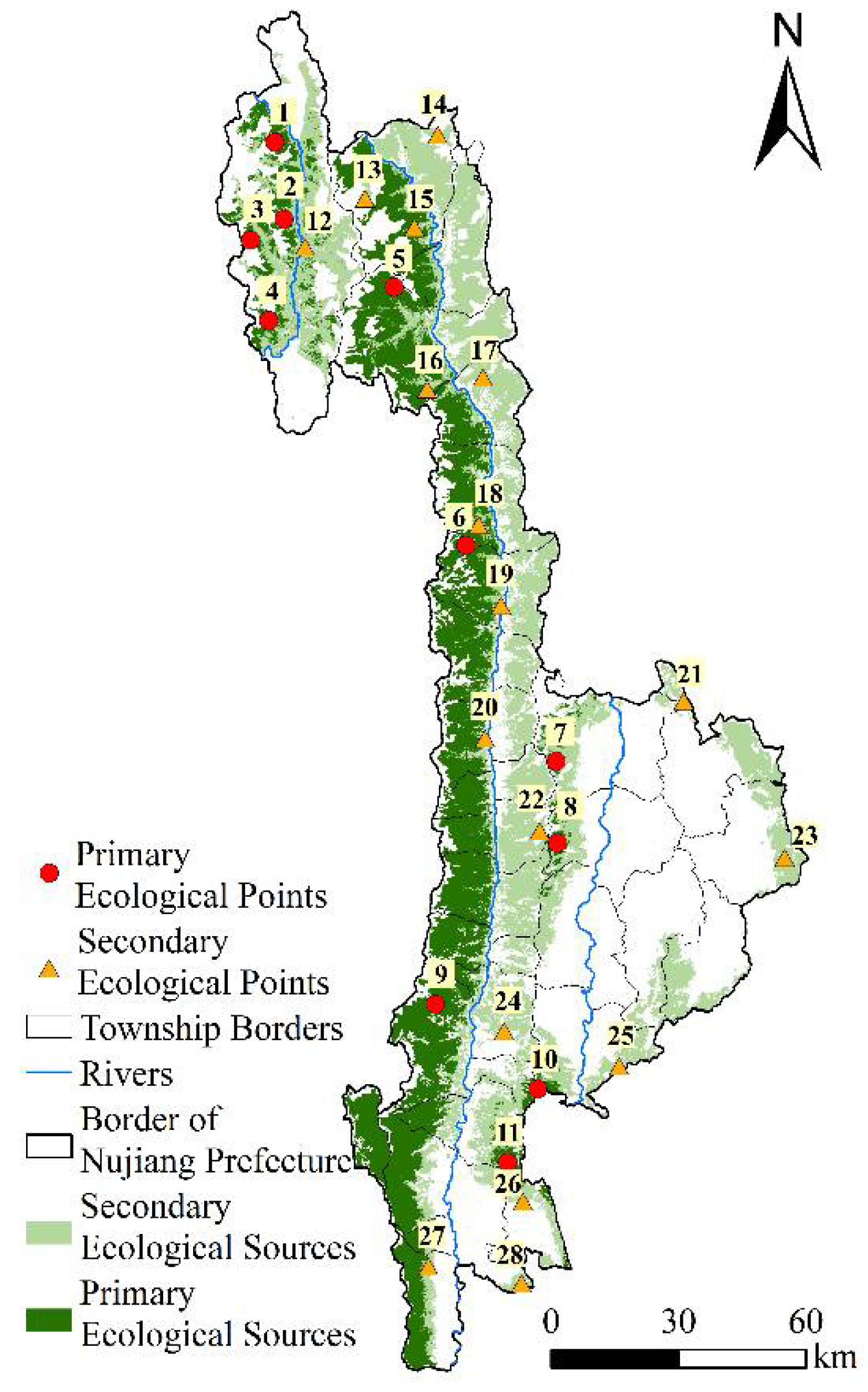
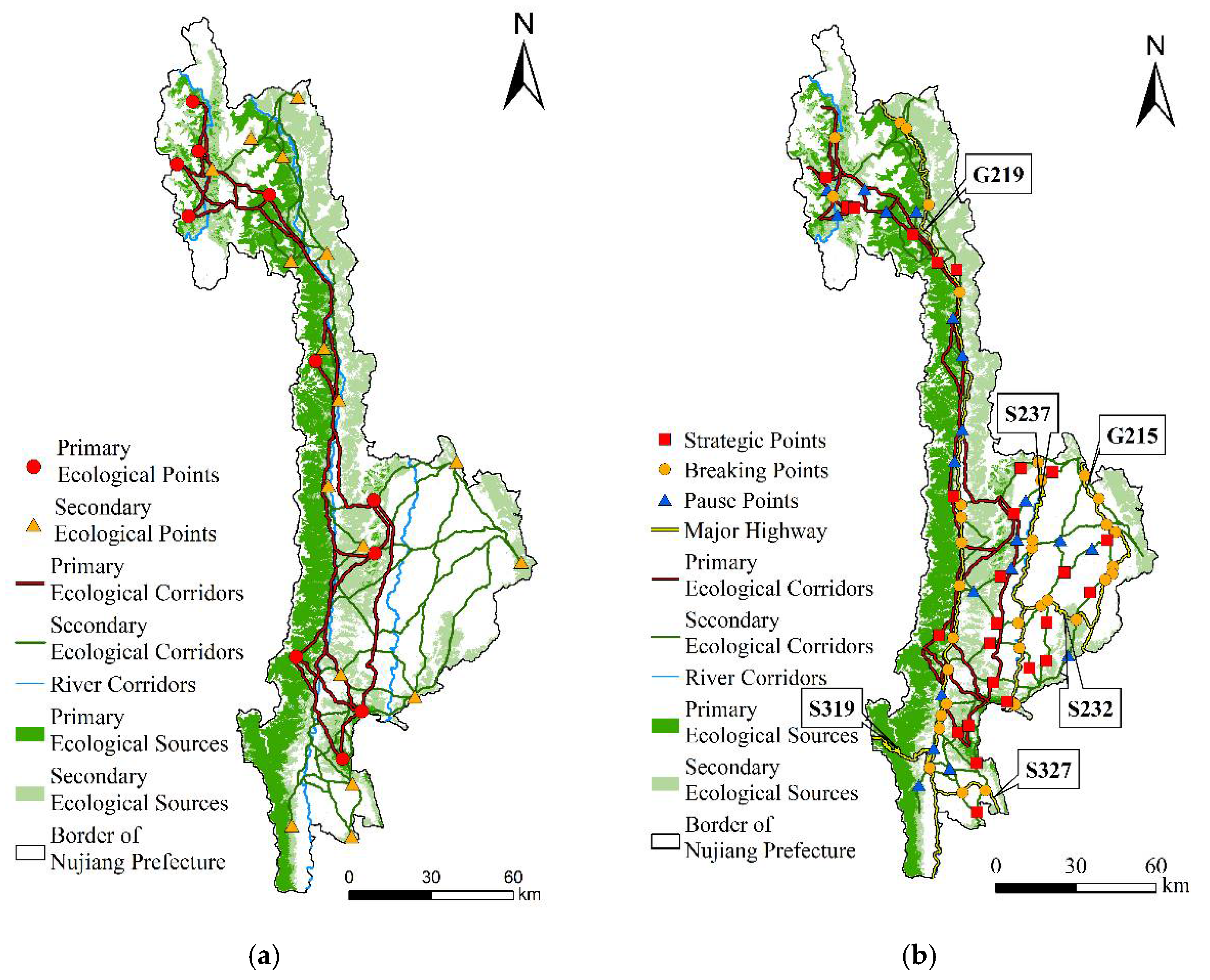
| Evaluation Types | Definition | Formula | Parameters Means |
|---|---|---|---|
| Water Conservation | WC refers to the ability to regulate precipitation interception, accumulation, and evapotranspiration of soil water resource [49]. | NPPmean is the average annual net primary productivity of vegetation; Fsic is the soil infiltration factor; Fpre is the average annual precipitation factor, the unit is [mm]; Fslo is the slope factor; K is the soil erodibility factor, the unit is [t·h/MJ·mm]; 1.2 and 1.63 are constants, each 1 g dry matter can fix 1.63 g CO2 and release 1.2 g O2. | |
| Soil Conservation | SC refers to the ability of an ecosystem to reduce or inhibit soil erosion and is a basic ecological regulation function [50]. | ||
| Carbon Sequestration | CS means that vegetation releases O2 and absorbs CO2 while producing organic matter through photosynthesis, which can maintain carbon and oxygen balance and regulate regional climate [51]. | ||
| Habitat quality | HQ refers to the ability of an ecosystem to provide suitable living conditions for individuals or populations [52]. | Qxj represents the habitat quality index of raster x in landscape pattern j; the value range of Hj is [0,1], representing the habitat suitability score of landscape type j; k is the half-saturation constant, which is set according to the accuracy of the data; Dxj is the habitat stress level of landscape type j grid x. |
| Landscape Index | Formula | Parameters |
|---|---|---|
| Integral index of Connectivity | n is the total number of patches; ai and aj are the areas of patches i and j, lij is the topological distance between patches i and j; AL is the total area of the study area and is a fixed value; is the maximum connection probability between patch i and patch j; IICremove and PCremove are the IIC and PC values of the remaining plaques after the elimination of a single plaque. | |
| Probability of Connectivity | ||
| Plaque Importance Value |
| Land Use Type | Forest | Grassland | Farmland | Water | Unutilized Land | Construction Land |
|---|---|---|---|---|---|---|
| Resistance coefficient | 1 | 10 | 30 | 50 | 300 | 500 |
| Classification (t/km2·a) | Erosion Intensity | Area (km2) | Proportion of Total Area (%) | Mean Erosion Modulus (t/km2·a) | Erosion Amount (t/a) | Proportion of Total Erosion (%) |
|---|---|---|---|---|---|---|
| 0–500 | Micro erosion | 9189.75 | 62.50 | 236.39 | 2,172,365.00 | 14.39 |
| 500–2500 | Mild erosion | 4011.77 | 27.29 | 850.61 | 3,412,451.68 | 22.60 |
| 2500–5000 | Moderate erosion | 783.44 | 5.33 | 3605.33 | 2,824,559.74 | 18.71 |
| 5000–8000 | Serious erosion | 393.53 | 2.68 | 6290.07 | 2,475,331.25 | 16.39 |
| 8000–15,000 | Polar erosion | 232.93 | 1.58 | 10,790.01 | 2,513,317.03 | 16.65 |
| >15,000 | Severe erosion | 91.58 | 0.62 | 18,577.77 | 1,701,352.18 | 11.27 |
| Total | - | 14703 | 100 | - | 15,099,376.87 | 100 |
| Sensitivity | Area (km2) | The Proportion of Total Area (%) | Number of Geological Hazards | Proportion (%) |
|---|---|---|---|---|
| Least Sensitive | 3458.42 | 23.52% | 2 | 0.13% |
| Less Sensitive | 4295.31 | 29.21% | 33 | 2.18% |
| Medium Sensitivity | 3503.98 | 23.83% | 135 | 8.91% |
| More Sensitive | 2297.35 | 15.63% | 352 | 23.22% |
| Most Sensitive | 1147.94 | 7.81% | 994 | 65.57% |
Publisher’s Note: MDPI stays neutral with regard to jurisdictional claims in published maps and institutional affiliations. |
© 2022 by the authors. Licensee MDPI, Basel, Switzerland. This article is an open access article distributed under the terms and conditions of the Creative Commons Attribution (CC BY) license (https://creativecommons.org/licenses/by/4.0/).
Share and Cite
Li, Y.; Zhao, J.; Yuan, J.; Ji, P.; Deng, X.; Yang, Y. Constructing the Ecological Security Pattern of Nujiang Prefecture Based on the Framework of “Importance–Sensitivity–Connectivity”. Int. J. Environ. Res. Public Health 2022, 19, 10869. https://doi.org/10.3390/ijerph191710869
Li Y, Zhao J, Yuan J, Ji P, Deng X, Yang Y. Constructing the Ecological Security Pattern of Nujiang Prefecture Based on the Framework of “Importance–Sensitivity–Connectivity”. International Journal of Environmental Research and Public Health. 2022; 19(17):10869. https://doi.org/10.3390/ijerph191710869
Chicago/Turabian StyleLi, Yimin, Juanzhen Zhao, Jing Yuan, Peikun Ji, Xuanlun Deng, and Yiming Yang. 2022. "Constructing the Ecological Security Pattern of Nujiang Prefecture Based on the Framework of “Importance–Sensitivity–Connectivity”" International Journal of Environmental Research and Public Health 19, no. 17: 10869. https://doi.org/10.3390/ijerph191710869
APA StyleLi, Y., Zhao, J., Yuan, J., Ji, P., Deng, X., & Yang, Y. (2022). Constructing the Ecological Security Pattern of Nujiang Prefecture Based on the Framework of “Importance–Sensitivity–Connectivity”. International Journal of Environmental Research and Public Health, 19(17), 10869. https://doi.org/10.3390/ijerph191710869






